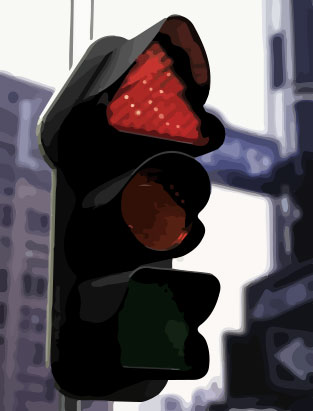InTrans / Oct 17, 2014
What color is that traffic light?
Go! Magazine
 posted on October 17, 2014
posted on October 17, 2014
“What color is that traffic light? This traffic light is horizontal, so I can’t tell which side is green!
Have you ever wondered how people with color blindness differentiate between green and red at a traffic light? For many people, this color confusion is a frightening reality. Color blindness affects about 8 percent of males and another 0.5 percent of females. Color blindness is typically caused by a genetic disorder inherited from the mother. One of the most common types of color blindness is referred to as red/green color blindness. This means that any color that contains red or green—such as purple or blue—will be seen as a different color to a person with color blindness. Thankfully there is a new technology to help this large percentage of people with color blindness.
Can you still drive?
Color blindness can affect people in different ways. See Figure 1 to see how the varying types of color blindness affects the ability to differentiate colors. As you can tell, trying to determine whether you should go or stop at a traffic light could be a bit tricky.

Now imagine if this traffic light was horizontal; you could no longer assume the top light means stop! In the US, people with color blindness are still able to drive. People in the US who are color blind can even become professional truck drivers, if they so choose. In contrast, Romania and Turkey do not allow people that are color blind to drive at all! The main limitation for the color blind in the US, and most other countries, is that they cannot be employed as a professional pilot. New technologies, however, may be able to change limitations to the color blind in the future.
Technology that may help drivers with color blindness
If you’ve ever experienced a glare on a traffic light impairing your ability to tell green from red, then you have shared an experience with a person with color blindness. Imagine if you always hesitated at traffic lights because you just were not sure the color of the traffic light. Figure 2 shows the newest technology to help people with color blindness differentiate the signals.

Instead of just relying on colors, this traffic light uses shapes to signal the correct response. This light is also proven to help improve reaction times for people without color blindness. If standardized, this traffic light could help drivers determine which action to take faster.
Experience Color Blindness
If you want to see more pictures of how people with color blindness see the world compared to you, check out this site.
Related information
This is the first article of a three-part series focusing on Driving with a Disability. Read “How do YOU drive” to get insight into how a disabled individual drives and the costs associated with driving a handicap-accessible van.
By Jackie Nester, Go! Staff Writer